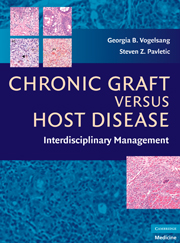Book contents
- Frontmatter
- Contents
- List of Contributors
- Preface
- PART I GENERAL PRINCIPLES
- PART II CLINICAL MANAGEMENT
- PART III ORGAN SITE OR SYSTEM-SPECIFIC MANIFESTATIONS
- PART IV SPECIAL CONSIDERATIONS IN CHRONIC GVHD
- 31 Design of Clinical Trials Testing Treatment for Chronic Graft versus Host Disease
- 32 Spectrum of Chronic Graft versus Host Disease in Unique Clinical Situations: The Role of Stem-Cell Source Including Cord Blood Stem Cells, Reduced-Intensity Conditioning, and Donor Leukocyte Infusions
- 33 Pediatric Chronic Graft versus Host Disease
- 34 Principles of Interdisciplinary Practice in the Care of Patients with Chronic Graft versus Host Disease
- 35 Patient Advocacy, Education and Psychosocial Support
- 36 Future Directions
- Index
- Plate section
36 - Future Directions
from PART IV - SPECIAL CONSIDERATIONS IN CHRONIC GVHD
Published online by Cambridge University Press: 26 August 2009
- Frontmatter
- Contents
- List of Contributors
- Preface
- PART I GENERAL PRINCIPLES
- PART II CLINICAL MANAGEMENT
- PART III ORGAN SITE OR SYSTEM-SPECIFIC MANIFESTATIONS
- PART IV SPECIAL CONSIDERATIONS IN CHRONIC GVHD
- 31 Design of Clinical Trials Testing Treatment for Chronic Graft versus Host Disease
- 32 Spectrum of Chronic Graft versus Host Disease in Unique Clinical Situations: The Role of Stem-Cell Source Including Cord Blood Stem Cells, Reduced-Intensity Conditioning, and Donor Leukocyte Infusions
- 33 Pediatric Chronic Graft versus Host Disease
- 34 Principles of Interdisciplinary Practice in the Care of Patients with Chronic Graft versus Host Disease
- 35 Patient Advocacy, Education and Psychosocial Support
- 36 Future Directions
- Index
- Plate section
Summary
Dr. Ernie Beutler wrote an amusing “what if” chapter about the future of hematopoietic cell transplantation (HCT) for the Thomas textbook. I'd like to recapitulate his tone and approach here in the final chapter of the Chronic GVHD book edited by Pavletic and Vogelsang.
What if in the future, chronic graft versus host disease (GVHD) as we know it was a historical footnote in the remarkable developmental history of HCT? Starting from myeloablative procedures using bone marrow from human leukocyte antigen (HLA)-identical siblings, the majority of transplants in the future would use minimal chemotherapy or targeted immunosuppressive agents to achieve donor engraftment from a variety of sources. The donor selection process will focus on testing the malignant and healthy tissues of the patient and the immune cells of the donor to precisely identify the risks for recurrent malignancy, acute and chronic GVHD, and treatment-related complications. Each patient's risk profile would be determined prospectively and the most appropriate donor selected to optimize the chance for disease-free, cGVHD free survival.
After transplantation, patients would receive prophylaxis and preemptive treatment for GVHD based on biomarker studies suggesting impending risk, an approach currently practiced in 2008 for Cytomegalovirus and Epstein Barr virus reactivation. However, future interventions for GVHD are largely intended to protect end organs so that other treatments have time to delete the offending cells, block the causative cytokines, or remove the recipient signals inciting the immune response. End organ dysfunction, disability, and death attributable to GVHD are largely prevented.
- Type
- Chapter
- Information
- Chronic Graft Versus Host DiseaseInterdisciplinary Management, pp. 406 - 408Publisher: Cambridge University PressPrint publication year: 2009

